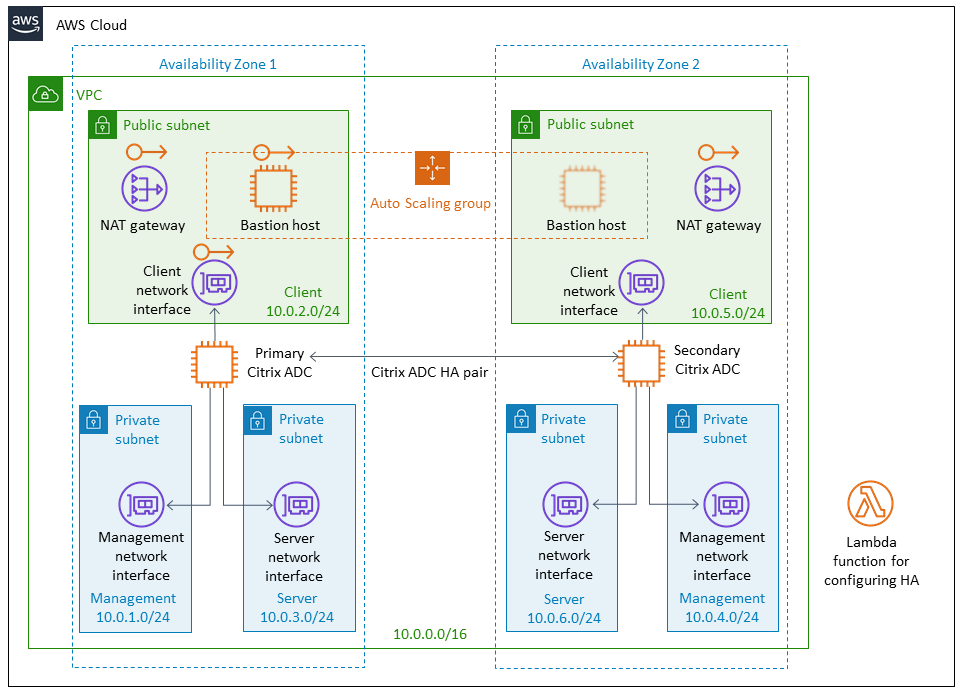reference deployment
Citrix ADC VPX for Web Applications on AWS
All-in-one application delivery controller
This Partner Solution deploys Citrix Application Delivery Controller (ADC) VPX for high availability (HA) to the Amazon Web Services (AWS) Cloud.
Citrix ADC VPX provides advanced Layer 4 (L4) load balancing, Layer 7 (L7) traffic management, global server load balancing, server offload, application acceleration, application security, and other essential application delivery capabilities for business needs.
This Partner Solution is for users who want to build and test a proof of concept or to create a production-ready solution with a highly available deployment of Citrix ADC VPX as a front end for web applications.

This Partner Solution was developed by Citrix Systems in collaboration with AWS. Citrix Systems is an AWS Partner.
AWS Service Catalog administrators can add this architecture to their own catalog.
-
What you'll build
-
How to deploy
-
Costs and licenses
-
What you'll build
-
The Partner Solution sets up the following:
- A virtual private cloud (VPC) that spans two Availability Zones, configured with two public and four private subnets, according to AWS best practices, to provide you with your own virtual network on AWS with a /16 Classless Inter-Domain Routing (CIDR) block (a network with 65,536 private IP addresses).*
- Two instances of Citrix ADC VPX, one in each Availability Zone.
- Three security groups, one for each network interface (Management, Client, Server), that act as virtual firewalls to control the traffic for their associated instances.
- In the public subnets:
- Managed network address translation (NAT) gateways to allow outbound internet access for resources in the private subnets.*
- A Linux bastion host in an Auto Scaling group to allow inbound Secure Shell (SSH) access to Amazon Elastic Compute Cloud (Amazon EC2) instances in public and private subnets.*
- An elastic network interface for Client (public).
- An Elastic IP address attached to the virtual server IP (VIP) of the primary ADC VPX instance.
- Managed network address translation (NAT) gateways to allow outbound internet access for resources in the private subnets.*
- In the private subnets, a network interface with a private IP address for the Management subnet (NSIP) and a network interface with a private IP address for the back-end Server subnet (SNIP).
- An AWS Lambda function to handle Citrix ADC VPX high availability and load balancing configuration.
- An AWS Identity and Access Management (IAM) role to securely control access to AWS services and resources for your users.
* The template that deploys the Partner Solution into an existing VPC skips the components marked by asterisks and prompts you for your existing VPC configuration.
-
How to deploy
-
To deploy Citrix ADC VPX to AWS in about 15 minutes, follow the instructions in the deployment guide. The deployment process includes these steps:
- If you don't already have an AWS account, sign up at https://aws.amazon.com, and sign in to your account.
- Subscribe to a Citrix ADC VPX Amazon Machine Images (AMIs). For information about the different AMIs that are available, refer to the deployment guide.
- Launch the Partner Solution. You can choose from two options:
- Test the deployment.
Amazon may share user-deployment information with the AWS Partner that collaborated with AWS on this solution.
- If you don't already have an AWS account, sign up at https://aws.amazon.com, and sign in to your account.
-
Costs and licenses
-
This Partner Solution requires a subscription. For more information about Citrix licensing, refer to Products and License Models.
If you don’t want to purchase a license file at this time, the Partner Solution can subscribe to the Citrix ADC VPX—Customer Licensed AMI, which allows 21 days of free usage and is available from AWS Marketplace. Additional pricing, terms, and conditions may apply.
You are responsible for the cost of the AWS services and any third-party licenses used while running this solution. There is no additional cost for using the solution.
This solution includes configuration parameters that you can customize. Some of these settings, such as instance type, affect the cost of deployment. For cost estimates, refer to the pricing pages for each AWS service you use. Prices are subject to change.
Tip: After you deploy a solution, create AWS Cost and Usage Reports to track associated costs. These reports deliver billing metrics to an Amazon Simple Storage Service (Amazon S3) bucket in your account. They provide cost estimates based on usage throughout each month and aggregate the data at the end of the month. For more information, refer to What are AWS Cost and Usage Reports?
